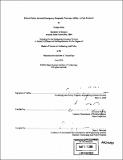Federal policy towards emergency responder interoperability : a path forward
Author(s)
Weir, Tristan John
DownloadFull printable version (5.120Mb)
Other Contributors
Massachusetts Institute of Technology. Technology and Policy Program.
Advisor
Lawrence McCray.
Terms of use
Metadata
Show full item recordAbstract
Emergency responders have suffered from a lack of cross-agency radio communications for the past three decades. After numerous firefighters died in the terrorist attacks of September 11, partially due to a lack of interoperability with police officers on the scene, the federal government began implementing policies, programs, and funding to improve interoperability amongst state and local first responders. This thesis explores the scope and the effectiveness of many of the federal efforts towards interoperability that have occurred between 2001 and 2006. Since 2001, the federal government has made progress in a number of areas relating to the national interoperability of first responders. These include: creating and reorganizing interoperability programs, such as SAFECOM within DHS; promoting open standards for equipment manufacturers; freeing radio spectrum for first responder use; and partially funding the purchase of new, interoperable communication equipment through grant programs and national initiatives. However, these efforts were slow to start, with the majority of progress only occurring within the past two years. Furthermore, the government has not set broad interoperability goals, and there are continuing questions about the amount of financial support that the government has offered and will continue to offer towards the problem. (cont.) The European Union and the U.S. military have both dealt with interoperability as well, and comparisons between these two entities and the U.S. federal government show that a lack of interoperability is both complex and has some possible solutions that remain untested in the United States. Five recommendations are presented to help the federal government forge a path forward. The government, through both the Department of Homeland Security and Congress, should: encourage collaboration between local public safety agencies; encourage better industry participation through equipment endorsements and public/private partnerships; create an interoperability grants program within DHS; prepare for a large increase in funding requests by 2009; and, establish a National Interoperability Goal with measurable results.
Description
Thesis (S.M.)--Massachusetts Institute of Technology, Engineering Systems Division, Technology and Policy Program, 2006. Includes bibliographical references.
Date issued
2006Department
Massachusetts Institute of Technology. Engineering Systems Division; Technology and Policy ProgramPublisher
Massachusetts Institute of Technology
Keywords
Technology and Policy Program.